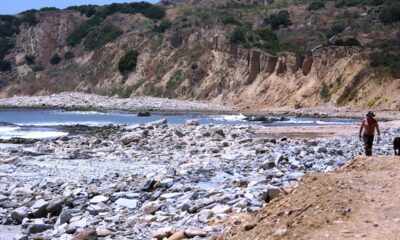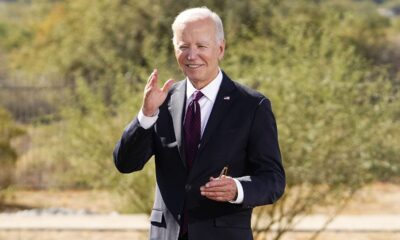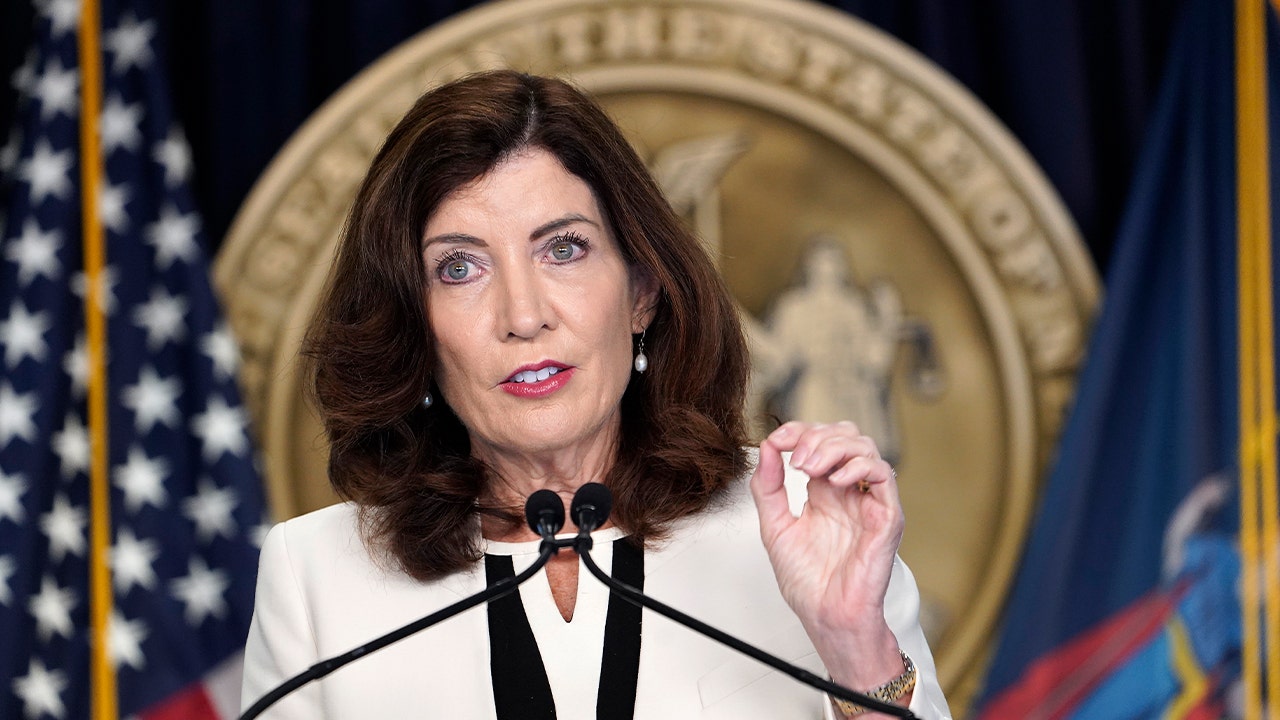Lifestyle
12 California experiences to add to your bucket list, one for every month of the year

Has it occurred to you that civilization might be overrated?
Me too. So I’ve been thinking about the natural world — actually, the many natural worlds contained within California, and how whole they can make us feel.
With that and the new year in mind, here are a dozen seasonally suitable classic California adventures. These are places where you can huddle with a loved one or steer clear of people entirely.
If you’ve been in the state a while, you’ve probably tried a few of them. Maybe you’ve meant to try a few more. And maybe 2025 is the year to act on that idea.
January: Spy on whales off San Diego

A gray whale swims in San Diego Bay.
(Birch Aquarium at Scripps Institution of Oceanography)
Gray whales migrate along the California coast from December through May, prompting winter whale-watching boats to head out regularly from harbors up and down the state. San Diego has a hefty supply of them, including Adventure Whale Watching (which uses rigid inflatable boats that are smaller and faster than the catamarans and other vessels most companies use), H&M Landing, San Diego Whale Watch, Oceanside Whale Watching and City Cruises by Hornblower. Excursions typically last two to four hours and cost $40 to $109 per adult.
On any of those boats, you should hear plenty about the wonders of Eschrichtius robustus (the gray whale), which gets up to 49 feet long, often migrating 10,000 miles (round trip) in a year.
Meanwhile, you may come across pods of dolphins — sometimes hundreds — leaping in the surf. Several dolphin species are common in these waters.
BTW: San Diego also has a few strong spots for whale watching from land, especially Torrey Pines State Natural Reserve in La Jolla and Cabrillo National Monument on Point Loma. If you don’t get around to chasing whales this winter, blue whales and fin whales swim through the same coastal waters May through November, and humpback and minke whales may be seen year-round.
February: Zip down Mammoth Mountain
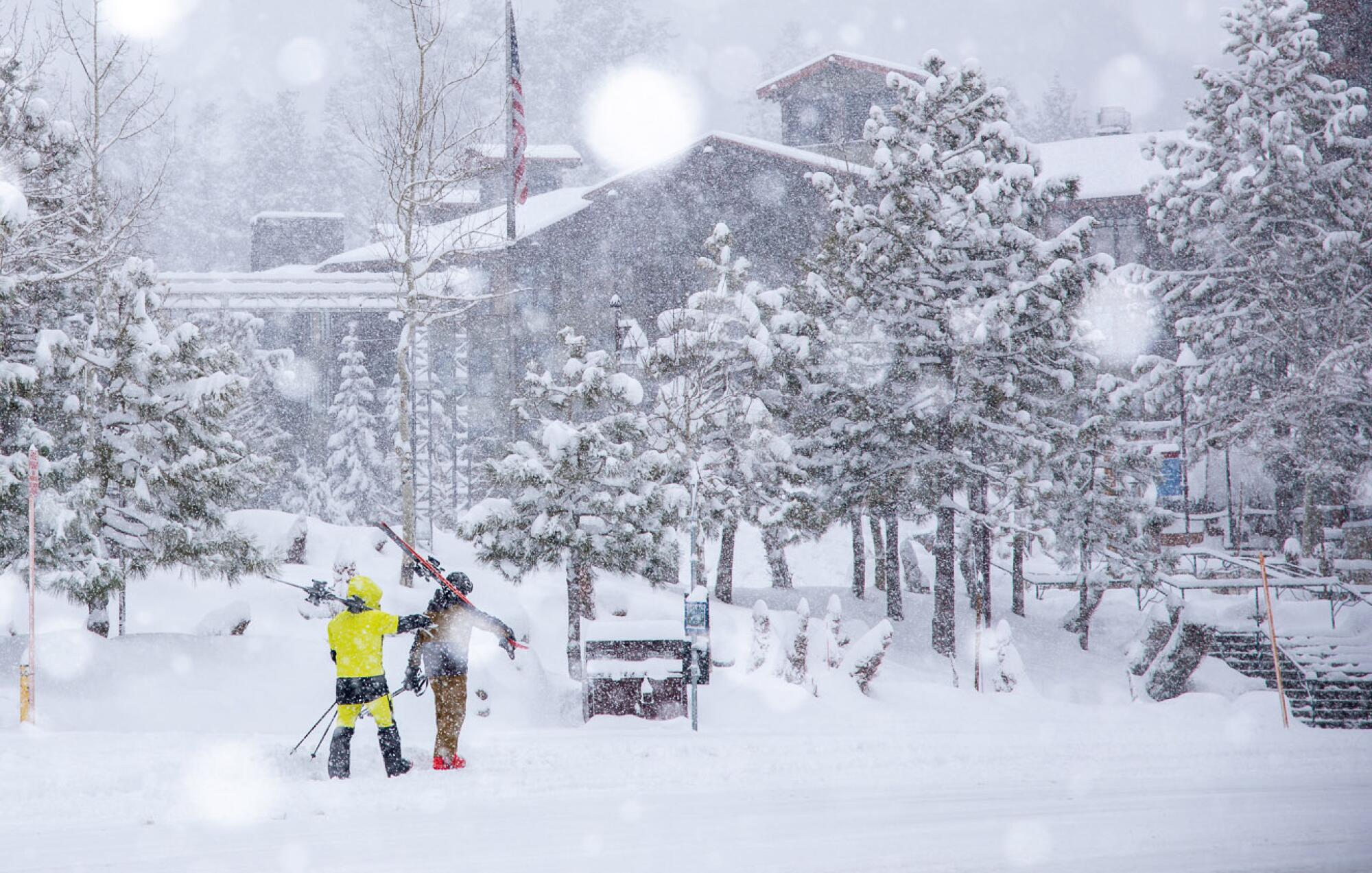
Skiers walking by the lodge at Mammoth Mountain in February.
(Samantha Lindberg / Visit Mammoth)
Every winter, legions zoom up from Southern California for winter sports at Mammoth Mountain (and many more come in other seasons for hiking, fishing and mountain biking). The ski and snowboarding operation, which includes 25 lifts, 3,500 skiable acres and a season that usually runs November through June, was founded in 1953 by a moonlighting hydrologist named Dave McCoy.
The mountain also has 19 miles of cross-country skiing based at the rustic lakeside Tamarack Lodge (which has the resort’s fanciest restaurant, the Lakefront) and 1,500 acres of beginner-friendly territory at nearby June Mountain (where kids 12 and under ski or ride for free).
BTW: To break up the 300-mile L.A. to Mammoth drive, detour into the rugged Alabama Hills near Lone Pine, where dozens of movies and TV shows have been filmed, including the first “Lone Ranger” film from 1938. Check out Lone Pine’s Museum of Western Film History. Farther up the road you’ll hit Bishop, the best place for a bite or overnight on the way to Mammoth.
March: Roam among Antelope Valley poppies

Visitors walk on a meandering path in the Antelope Valley California Poppy Reserve.
(Francine Orr / Los Angeles Times)
The Antelope Valley California Poppy Reserve’s rolling hills go orange in spring, usually March to May. The poppy bloom, which varies widely from year to year, can blanket the slopes. Purple lupine and other wildflowers may show up too. This 1,781-acre preserve ($10 per car to enter) includes eight miles of broad, smooth paths for walking among the flowers. (A portion, just west of the visitor center, is wheelchair-accessible.) Don’t pick any poppies or go tromping off-trail. But you can lead your friends to a high spot, such as Antelope Butte Vista Point to the east or Tehachapi Vista Point to the west, and then casually mention that Eschscholzia californica has been the state flower since 1903.
BTW: In years like 2019, when a superbloom attracted thousands of visitors, the reserve’s parking lot isn’t nearly big enough. (In 2024, the parking was easy because the blooms were subpar.) Bear in mind that many poppies bloom on roadside slopes outside the reserve. If you can do so safely, legally park on a shoulder along or near Lancaster Road and you might save $10.
April: Hear Burney Falls roar
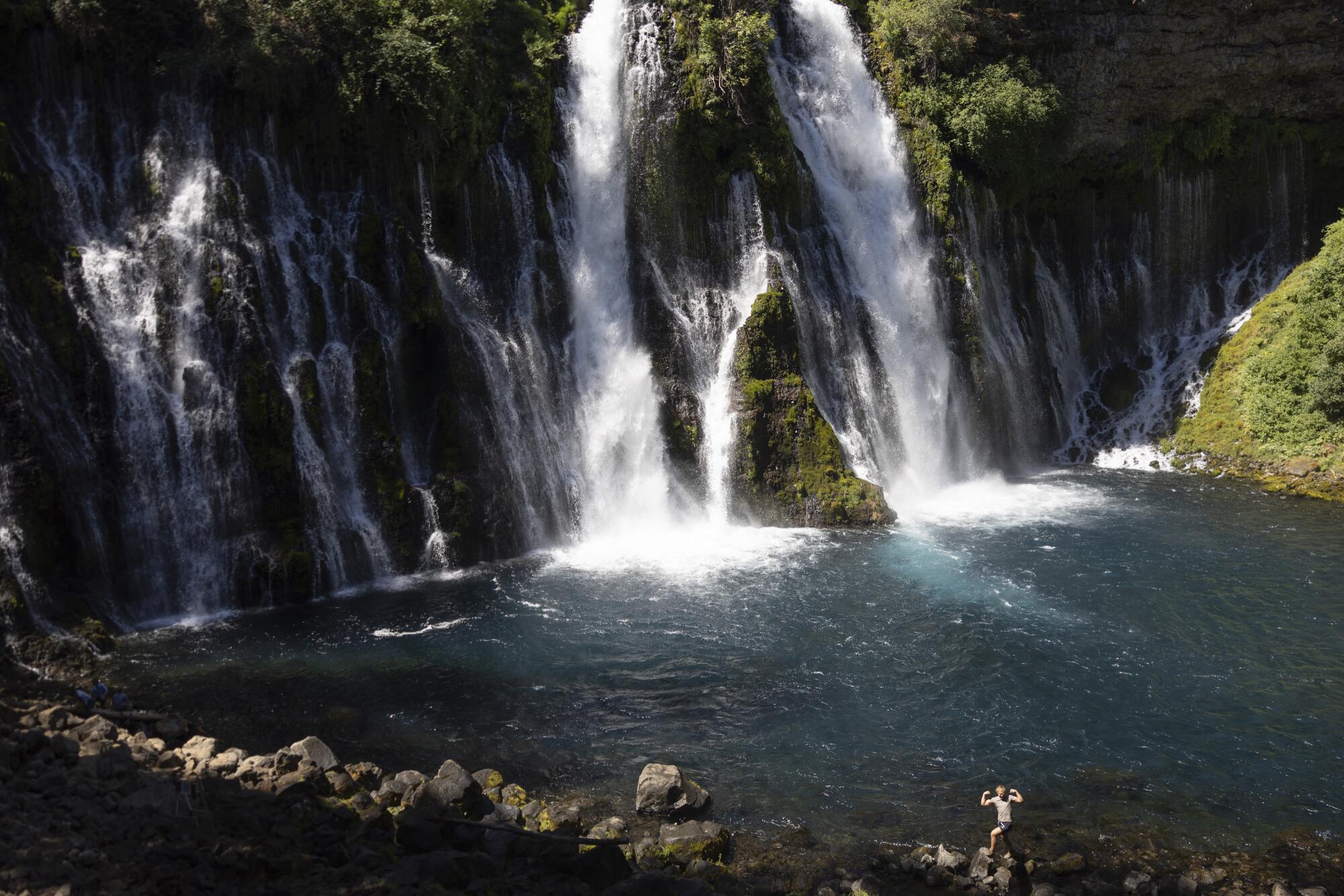
A visitor stands beside Burney Falls in California’s Shasta County.
(Paul Kuroda / For The Times)
Near the northern edge of California, you can see four or more waterfalls in a day. But some get crowded on summer weekends, so a visit in spring (especially on a weekday) will give you more elbow room. The big one is Burney Falls, 129 feet high, with a wide, thundering cascade. It’s the headliner at McArthur-Burney Falls Memorial State Park, about 65 miles northeast of Redding ($10 to enter; note that some trails, including the Falls Loop Trail, have been closed for long-term maintenance work).
Next, head to McCloud Falls, a series of three cascades about 45 miles northwest of Burney Falls along California 89. It’s seven miles round trip to hike the trail connecting the three cascades; all are part of Shasta-Trinity National Forest, with campgrounds nearby.
May: See green along Highway 46, west of Paso Robles

A sightseer stands along Highway 46, west of Paso Robles.
(Christopher Reynolds / Los Angeles Times)
So long as it rains just a little in spring, the drive along Highway 46 between Paso Robles and the San Luis Obispo County coast is 22 miles of scenery so green and gorgeous, it’s a traffic hazard. Verdant hills. Grizzled oaks. Grapevines in formation like troops about to march. Country roads that will take you to tasting rooms. As you head west, you’ll glimpse Morro Rock and the blue Pacific in the distance. When you reach the traffic circle at Vineyard Drive, about 4.6 miles west of Highway 101, you may be tempted to wander off on Vineyard for a few miles of low-speed bucolic splendor. Do it. When you’re westbound on 46 again, you’ll find several scenic turnout spots as it twists and swoops to its end at Highway 1. From there, you’ll be choosing between Cambria (4 miles north) and Cayucos (11 miles south), with the hamlet of Harmony on the way.
BTW: If you’re overnighting in Paso Robles, consider Sensorio, a walk-through display of ever-changing lights, most of it concocted by artist Bruce Munro. Imagine electric flowers with a dimmer switch. (And in some displays, the changing colors are set to music.) It’s generally open Thursday through Sunday nights. Adult all-access passes start at $65.
June: Raft the American River’s South Fork
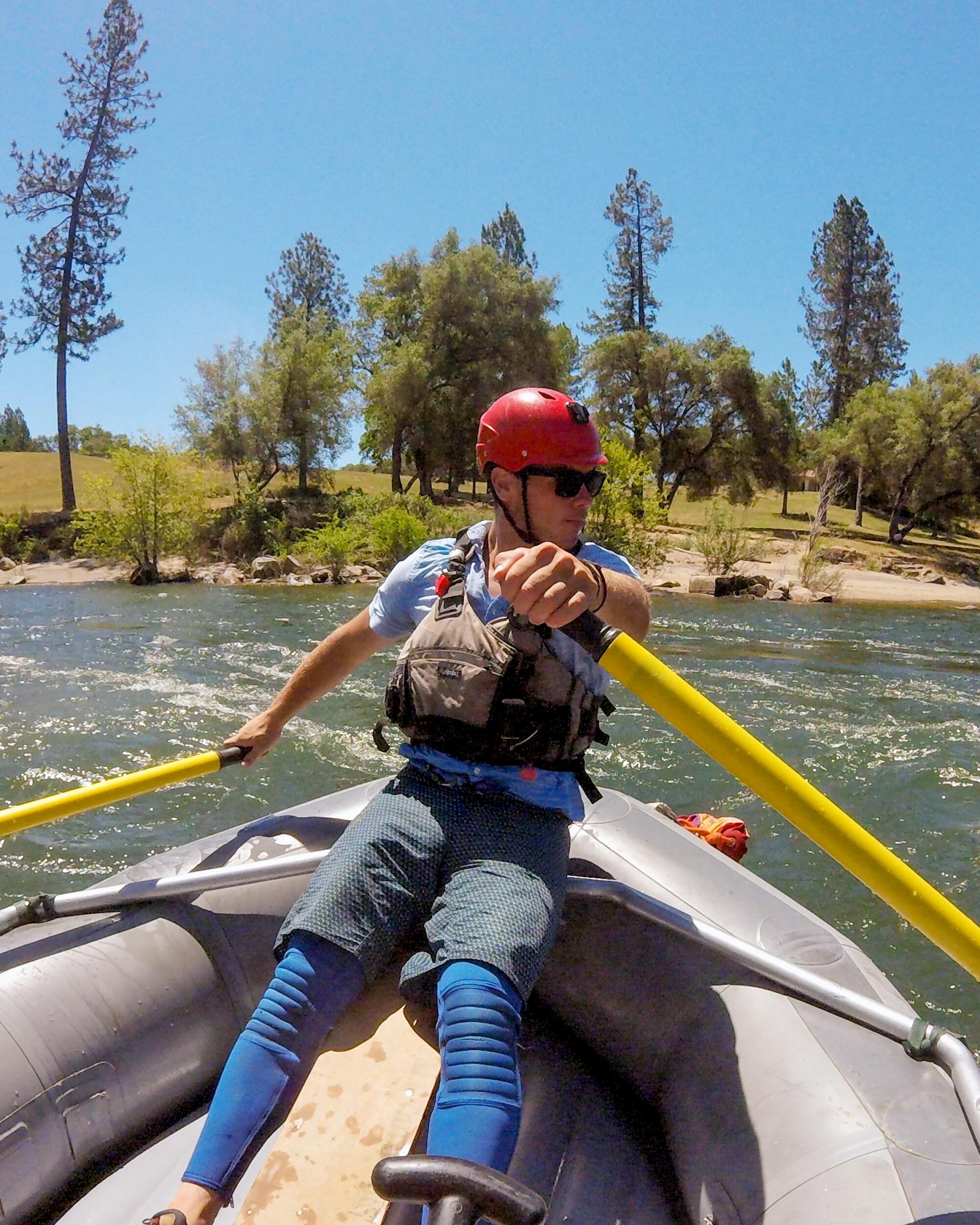
River guide Kyle Brazil navigates the South Fork of the American River, near Coloma.
(Christopher Reynolds / Los Angeles Times)
Running a river is a signature thrill in California’s Gold Country — and if it’s early summer, you can expect a few splashes of cold water on your face. Guides say the South Fork of the American River is a perfect introduction to river rafting, thanks to its evocative scenery, relatively mild Class III rapids and proximity to campgrounds and the pleasant town of Placerville.
Rookies should sign on with a licensed, experienced company. Family-friendly river floats typically begin north of Placerville, below the Chili Bar Reservoir, near Coloma. All-day rafting trips typically cost $100 to $180 per person. Half-day trips also are often available.
BTW: Marshall Gold Discovery State Historic Park, where the Gold Rush began, is less than a mile from many of Coloma’s whitewater rafting outfitters along California 49.
July: Soar (or stand by) at the Torrey Pines Gliderport

Torrey Pines Gliderport sits on a cliff top in La Jolla next to the UC San Diego campus.
(Christopher Reynolds / Los Angeles Times)
This is the place to see people jump off a cliff, then rise on the updraft. The gliderport sits between the UC San Diego campus and the Pacific, sending skyward a steady stream of paraglider pilots and the occasional model airplane. Grab breakfast or lunch at the Cliffhanger Cafe (where none of the soup or sandwiches costs more than $11.25), settle in at a picnic table and watch the action in the air. (On Saturday afternoons in summer, there’s usually live music.)
Sail planes were taking off here as early as the 1920s. In 1930, Charles Lindbergh glided on these winds. Hang gliders joined in the 1970s, then paragliders, then tandem paraglider flights (bookable for $200). See the shoreline about 200 feet below? That’s Black’s Beach, accessible by a steep, half-mile trail. (The beach also has a nude zone.)
BTW: For a smoother hike to the beach and equally amazing views, try the Torrey Pines State Natural Reserve. For straight-up beach time, head for the sand beneath the cliffs at Torrey Pines State Beach.
August: Camp or kayak at Santa Cruz Island

The tide laps at Scorpion Anchorage on Santa Cruz Island, Channel Islands National Park.
(Christopher Reynolds / Los Angeles Times)
On a clear day, you might glimpse the silhouette of Santa Cruz Island from the California mainland. But it takes a boat ride out there — ideally followed by a night of camping — to appreciate the island’s rugged bluffs, flowery meadows, raw beaches and sea caves. It’s the largest section of the chronically under-visited Channel Islands National Park.
The island’s Scorpion Anchorage, where most visitors arrive, is about an hour’s boat ride via Island Packers from Ventura Harbor. You can do a day trip or camp. Either way, you can snorkel and kayak in sea caves with a guide and rented vessel from Channel Islands Adventure Co. Or hike to Smugglers Cove. On your way, keep an eye out for island foxes, once endangered, now plentiful and skilled in campsite food thievery. (Island Packers, which has sailed among the Channel Islands for decades, is the National Park Service’s concessionaire for transport to and from the mainland.)
Once, the island’s hills and valleys were home to 11 Chumash villages (and Santa Cruz served as a sheep ranch as recently as 1984). Nowadays, there’s one 31-site campground about half a mile’s walk from Scorpion Anchorage. The park service controls about a quarter of Santa Cruz. The rest, owned by the Nature Conservancy, is off-limits.
BTW: If you only have time for a day trip, consider nearby Anacapa Island, home to a 1932 lighthouse, spectacular views and two miles of trails. But maybe wait another month. During the March-through-August nesting season, that island sees enough swooping, shrieking, pooping seabirds to trouble Alfred Hitchcock’s dreams.
September: Hike Yosemite, far from cars
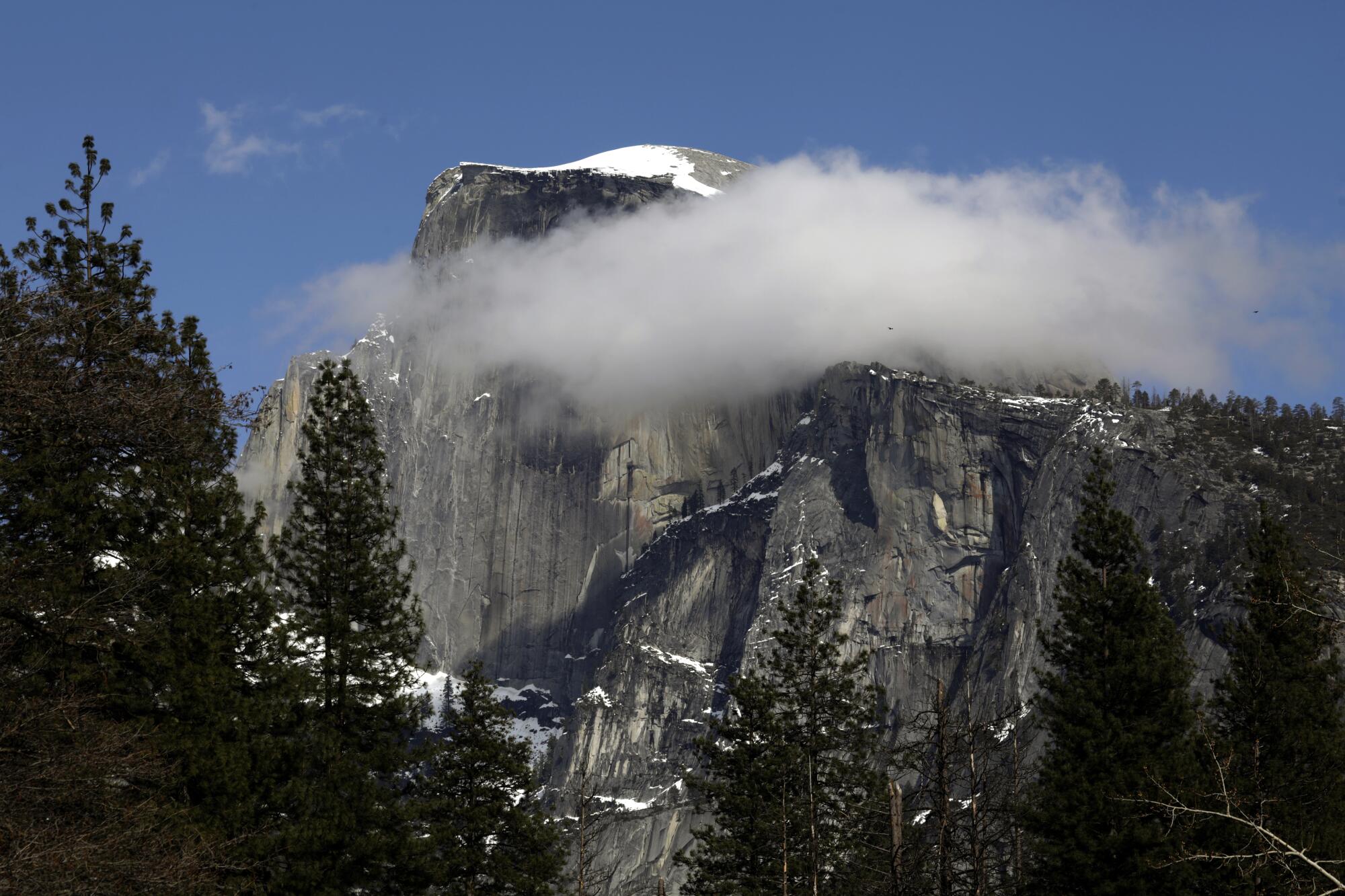
Yosemite National Park’s Half Dome, dusted with snow, rises above Yosemite Valley.
(Carolyn Cole / Los Angeles Times)
Yosemite National Park is vast, gorgeous and busy in summer, even when there’s a day-trip reservation requirement in place. But if you wait until the second half of September, when most kids have gone back to school, the chaos is reduced. And as soon as you get one mile from the nearest road, chances are you’ll see a lot more trees than people. Be sure to check reservation requirements well ahead.
Once there, if you’re a newbie, head for Yosemite Falls, the great spigot of Yosemite Valley and North America’s tallest waterfall, a 2,425-foot medley of cascades down granite walls. Later maybe climb the Yosemite Falls Trail to Columbia Rock (two miles round trip). Or try the Mist Trail to the top of Vernal Falls.
But remember, the valley is six square miles in a 1,187-square-mile park. From there, you could drive into the high country and catch the panorama from Glacier Point. You could check out the Hetch Hetchy Valley. You could take Tioga Road (which usually closes for the winter in November, reopening in late May or June) to Olmsted Point, Tuolumne Meadows and Tenaya Lake.
BTW: Lodging options inside the park have shrunk with the indefinite closure of the Wawona Hotel on Dec. 2. Also bear in mind: An extensive seismic retrofit was due to continue at the Ahwahnee Hotel through the end of 2024; and Aramark, the concession company whose subsidiary runs the Ahwahnee and other Yosemite operations, has been faulted by parks officials for multiple operational lapses in the last two years.
October: See trees at Prairie Creek Redwoods State Park

Fern Canyon Trail in Prairie Creek Redwoods State Park greets visitors with 50-foot fern-covered walls.
(Myung J. Chun / Los Angeles Times)
In Prairie Creek Redwoods State Park, about 50 miles north of Eureka, Prairie Creek Trail leads hikers through a grove of implausibly tall old trees. The park’s Elk Prairie and Gold Bluffs Beach campgrounds also are popular, and its mile-long Fern Canyon trail is famed as a shooting location for the “Jurassic Park” movie “The Lost World.”
The surrounding Redwoods National and State Parks include miles of trails and coastline north and south of the Klamath River estuary, including the rocky coastal view from High Bluff Overlook. Even in summer, this territory is relatively uncrowded. In fall, that will be doubly true. (Del Norte County’s population is less than 30,000.) Just be ready to be cool and damp. If you need a bed or breakfast, consider the Historic Requa Inn, a rustic landmark alongside the Klamath River that dates to 1914.
November: Gather driftwood at Moonstone Beach
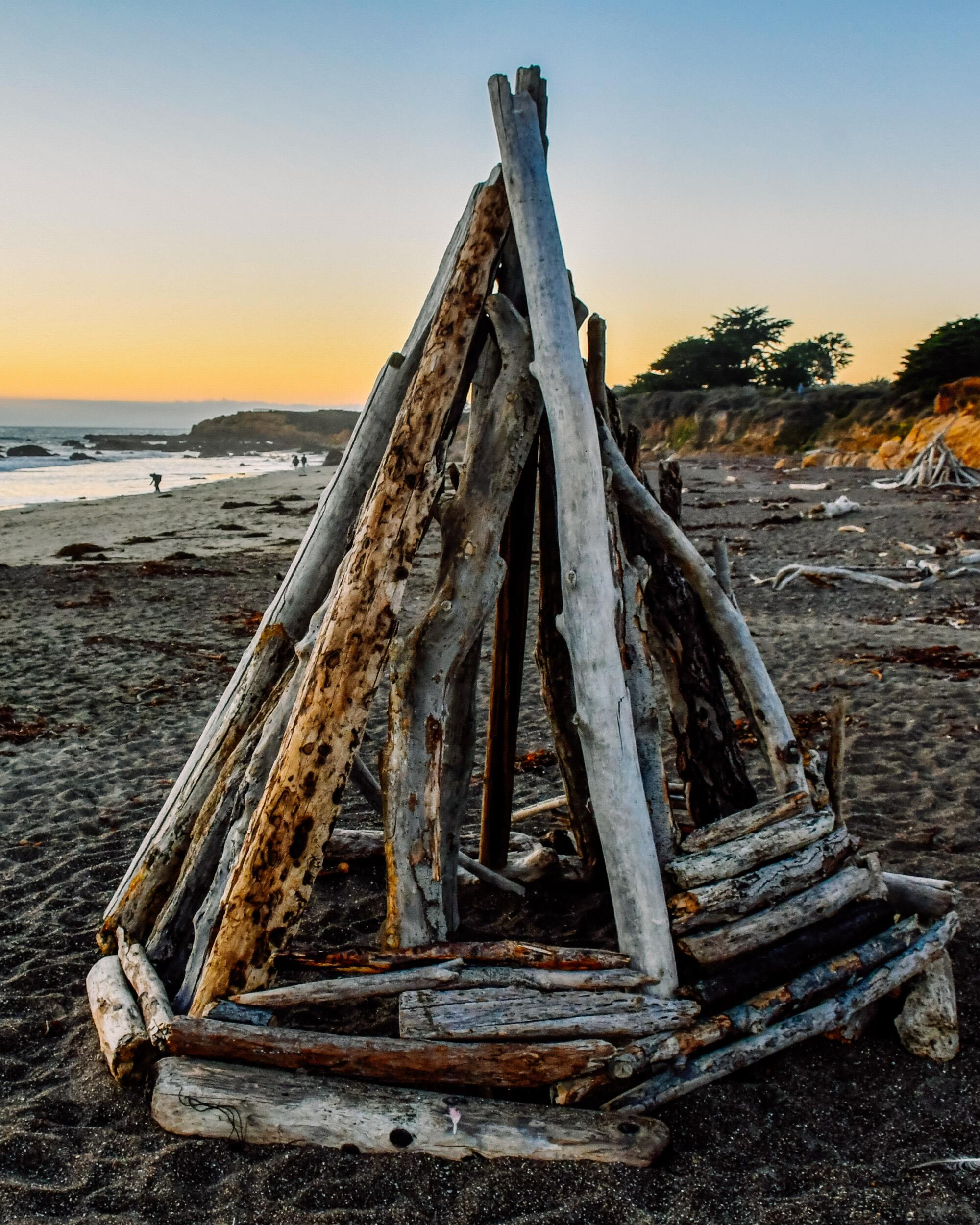
Cambria’s Moonstone Beach Drive features rocky coastline and abundant driftwood.
(Christopher Reynolds / Los Angeles Times)
Cambria is a coastal town for all seasons. The shoreline is mostly rugged and rocky, with pines marching up steep, often-foggy slopes. In the midst of this waits Moonstone Beach, often strewn with driftwood, and Moonstone Beach Drive, which is lined by about a dozen inns and boutique hotels.
Stroll the mile-long Moonstone Beach Boardwalk. Make a fort out of some driftwood. Hike on the Fiscalini Ranch Preserve‘s Bluff Trail. Sample the eclectic menu at Robin’s Restaurant (a mainstay for more than 25 years), dig into olallieberry pie at Linn’s Restaurant (more than 30 years). Or stand in line for seafood at the cash-only, no-reservations Sea Chest Oyster Bar, which turns 50 in 2025.
BTW: Remember to visit San Simeon and Hearst Castle, about nine miles up the road. Also remember that you can’t continue up Highway 1 to Big Sur. The highway is closed two miles north of Lucia for major repairs. Caltrans officials say they expect to reopen some time in 2025, with a date to be determined.
December: Hug a boulder in Joshua Tree’s Hidden Valley
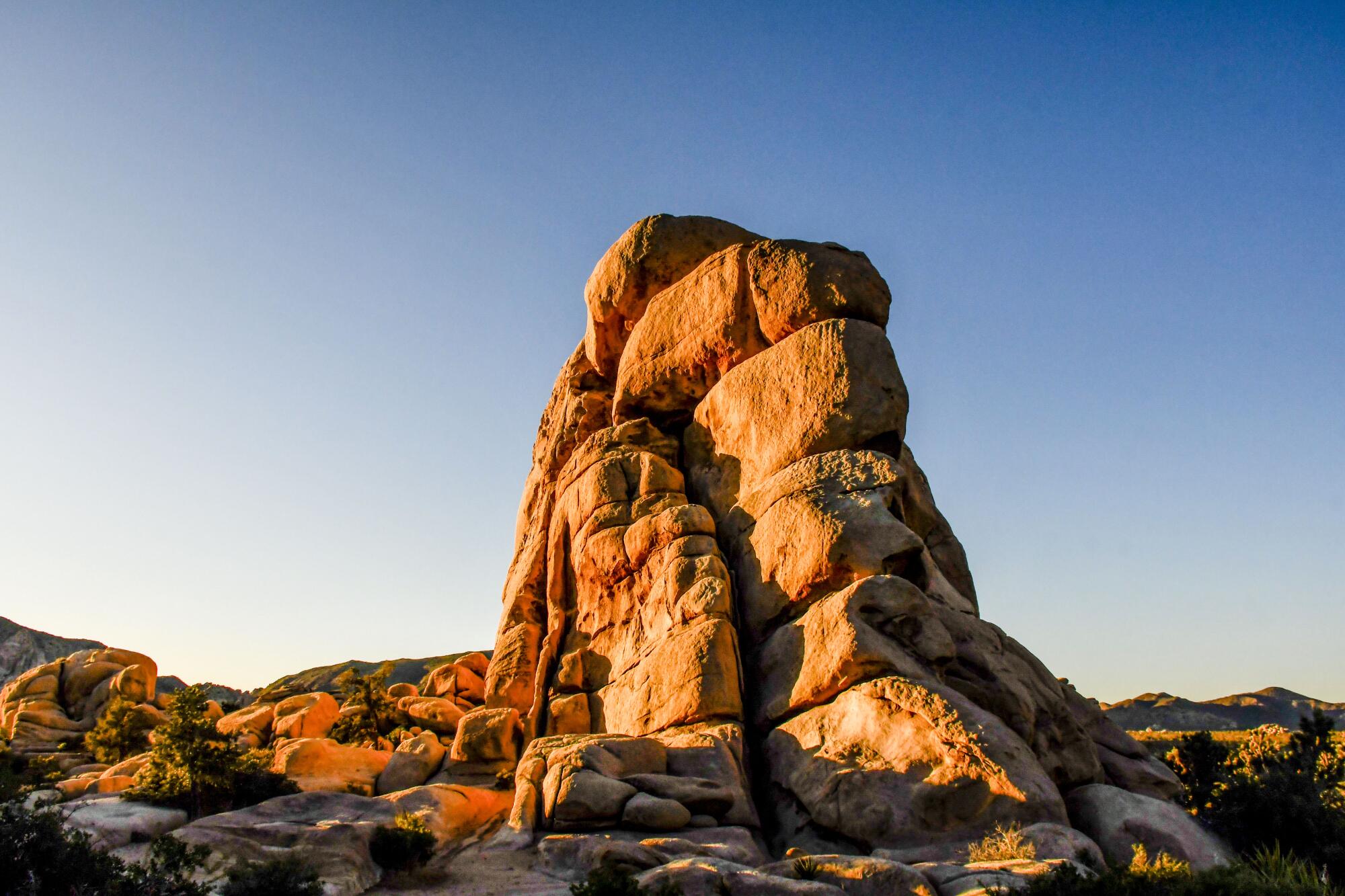
Climbers and campers revere Hidden Valley in Joshua Tree National Park.
(Christopher Reynolds / Los Angeles Times)
Hidden Valley in Joshua Tree National Park draws climbers, boulderers, desert campers and geology geeks from all over. Hidden Valley has 44 first-come, first-served campsites (Joshua Tree has about 500 campsites total) and no water — but those rocks! They look even more amazing when reflected in the water that sometimes accumulates at nearby Barker Dam. There’s also prime stargazing and edgy art around the fringes of the park, courtesy of Noah Purifoy, High Desert Test Sites, Desert X and others.
BTW: If you don’t know much about singer-songwriter Gram Parsons’ life and death, you could book the Joshua Tree Inn, where Parsons spent his last night in Room 8.

Lifestyle
Apple TV+ is free this weekend. Here's what we'd watch

Anna Konkle in The Afterparty on Apple TV+
Apple TV+
hide caption
toggle caption
Apple TV+
Subscribing to every streaming service out there is not an option for most people. It just isn’t. They’re too expensive, there are too many, and it’s also just a lot of work to keep track of so many options and apps and interfaces. Some folks pick and choose, while some folks use the rotation method (service #1 for a few months to catch up, then service #2 for a few months to watch their stuff, and so forth).
Apple TV+ is free this weekend for anybody who has an Apple ID. It’s a service that has not taken off the way some people thought it might, despite having some successes — Ted Lasso in particular. I’m not here to tell you to pick this service over any other one, or to pay for it at all. But I am here to give you a little advice on what might be worth using this free weekend to catch, since they’re giving it away.


Some things (aside from Ted Lasso) have gotten a ton of good press already. Severance is a spooky, beautifully designed drama/sci-fi story about the drudgery of office life, and it’s starting again in a couple weeks, so now could be the perfect time to catch up. Pachinko is a really moving saga based on Min Jin Lee’s novel of the same name. My current favorite show, if I had to name one, is Shrinking, a very funny and often very emotionally rich story about a bunch of great characters, many of them therapists — it also features my favorite Harrison Ford performance in years and years and years. Bad Sisters, especially the first season, is a delicious and fabulously performed story of devoted siblings getting the better of a terrible, terrible husband.
Other favorites of the TV critics I know: Dickinson, Slow Horses, For All Mankind, Silo, and this year’s Cate Blanchett drama Disclaimer. And they’ve got movies, too: Coda won best picture at the 2022 Oscars, after all.
But maybe you feel like “yes, yes, I’ve heard of all those things.” So let me spotlight a handful of other Apple offerings that haven’t gotten quite as much attention that you might enjoy.

- The Afterparty: This series stars a murderer’s row of comic actors — in the first season it was folks like Sam Richardson, Ben Schwartz, John Early, Ike Barinholtz, Tiya Sircar and Ilana Glazer — in an actual murder mystery that takes place at a high school reunion. Every episode is done in a different genre (musical, action picture, rom-com). It’s a lot of fun, and if you enjoy comic mysteries as much as I do, it might be right up your alley.

- Platonic: I was a big fan of this show, starring Seth Rogen and Rose Byrne as best friends who reunite after a long time out of touch. It’s really funny, but it also has a nice feel for actual platonic friendships (it is not about whether they are going to kiss) and their complications. If you like your comedies to be proudly and brightly funny rather than heavy and high-concept, give it a shot.
- Sharper: This film is a thriller that I feel like absolutely nobody saw except me — but again, it was right up my alley. It’s a twisty story about New York scammers starring Julianne Moore, Sebastian Stan and Justice Smith. There are reversals and betrayals and ooh, it was kinda fun.
- Flora and Son: This movie is about a single mom, played by Eve Hewson, who takes guitar lessons remotely with a laid-back guy played by Joseph Gordon-Levitt. It was written and directed by John Carney, who made Once and Sing Street, so you are in good hands. He just has a way with big musical moments, and I really enjoyed where this one ended up.
- Boys State and Girls State: Boys State and Girls State are twin documentaries about leadership programs for high school students, and both are absorbing and sobering, particularly when seen side-by-side.
This piece also appeared in NPR’s Pop Culture Happy Hour newsletter. Sign up for the newsletter so you don’t miss the next one, plus get weekly recommendations about what’s making us happy.
Listen to Pop Culture Happy Hour on Apple Podcasts and Spotify.

Lifestyle
Opinion: What I find in solitude and silence on the cliffs of Big Sur

As a student, like many of us, I liked to read Henry David Thoreau. Many of his ringing one-liners thrilled me and got copied down in my commonplace book, but there was one sentence I hardly registered: “Every man is tasked to make his life, even in its details, worthy of the contemplation of his most elevated and critical hour.” In my early 20s, my life was all about action, movement, exploration: Contemplation was for the aged in their rocking chairs.
Within a few years, though, real life began to catch up with me: I’d completed my first four years in an office; I’d fallen in love with the woman I was going to marry; I’d been lucky enough to see much of the globe, from Cuba to Tibet. More dramatically, my house had burned to the ground in a wildfire, and I’d lost not only all my possessions, but also the handwritten notes that were the basis for my next three books. My future, in short, as much as my past.
After weeks of sleeping on the floor of a friend’s house, I made my way up (at another friend’s suggestion) to a Benedictine hermitage, four hours north along the California coast, just south of the hamlet of Lucia. I would try to forget that 15 years of Anglican schooling as a boy in England had left me most interested in traditions from the far side of the world. What I found at the top of the mountain, the minute I stepped out of my car, was a radiant view over the blue Pacific, freedom from all distraction (no TV, no cellphones, no internet) and a day that seemed to last for months. I could read, take walks, scribble off letters or, best of all, do nothing at all. The roar of the highway was far below, and for most of the day, even amid birdsong and tolling bells, the main sound was of living silence.
I’d stumbled, in short, into the realm of contemplation. I’ve never meditated, and as a writer on place, I was often in motion, crisscrossing the globe every week. But now I was invited just to sit and watch — not as I did when writing, but with no end in sight at all. And not to think, since my thoughts subsided as soon as I left clamor behind; just to attend. To observe the world, perhaps, as if it were the central scripture.
The results were quite startling. I was no longer angry with that friend I’d been raging against when I drove up; he, too, was probably just trying to find some peace in an overstressed life. Memories rose up — sometimes poignant, sometimes erotic and piercing — and they held and possessed me as they never could when I was driving along the freeway, preoccupied with my next appointment. Death itself didn’t seem quite so terrifying in a landscape of rock and redwood and unbroken ocean — and in a silence that seemed no less changeless. It was instant joy, in short, the kind that lingers even when things are difficult.
I was being asked to offer just $30 a night, which covered hot lunches, hot showers, books and fruit and salad and bread, and the most heart-expanding views along the famously beautiful coastline I’d ever discovered.
It’s not surprising, perhaps, that very soon I reserved a trailer on the hillside for two weeks, and then three. The monks were great company and bracingly undogmatic; they were confident each of us would find what we needed here, whatever names we chose to give to it. I could drive down to a pay phone at the motel along the highway if an emergency arose — but emergencies are never so common as we imagine. Of course it was not easy to leave my mother or my wife-to-be behind, but it felt worthwhile if I could bring back to them someone who was fresh and attentive and brimming with delight, and not the distracted and overburdened soul they otherwise saw, grumbling, “Not right now!”
At the same time, I could never ignore that sentence in Thoreau, whom I was reading much more carefully now in silence: How to make my life worthy of what I saw and who I was — and wasn’t — in this space of contemplation? I wasn’t a monk and never would be. My mother was calling for company after her husband’s sudden death; my loved ones in Japan needed emotional as well as financial support; I had to pay the bills.
Maybe I could try to remake my life a little in the light of what I’d seen in silence? I surprised both my sweetheart and myself by moving to Japan and a tiny, two-room apartment, crowded with her, her 12-year-old son and her 10-year-old daughter; I’d realized, as Thoreau reminded me, that “a man is rich in proportion to the things he can afford to leave alone.” In this cramped space, I’d have the luxury of living without a car or a big house, free of constant distractions. I began to pick up some of the wise writers in the Western tradition — Meister Eckhart, Etty Hillesum — no longer convinced that Sufis or Buddhists owned a monopoly on wisdom. And I resolved to try to go on retreat for three days every season, simply to clear my head, root myself in what mattered and remember what I loved.
Plus, of course, to get perspective on the world and my life in it, none of which I could see in the midst of all the tumult. Some friends take runs every day, or swims, for the same reason; some cook or sew or golf. Almost any practice that allows you to open space in your day and your head seems invaluable, especially as the world accelerates, but it was a particular luxury to spend three days and nights with nothing I had to do. Even on holiday, I’m usually captive to my plans.
As the years went on — there have been almost 34 of them now, and more than 100 retreats — the nature of my days in silence began to mature. Not only did silence bring those I cared about close to me — and clearer — than they might be when in the same room; it also turned the strangers along the monastery road into trusted friends. We were all here for a common purpose, and it wasn’t usually a text or a teacher or even a doctrine; it was simply a human longing (or intimation). I grew ever closer to the monks, a wildly talented and friendly collection of scholars, musicians, artists and chemists; I realized I had a connection with everyone met in silence — even if I knew next to nothing of their jobs or their backgrounds — that I seldom had with people met along a busy sidewalk.
I came to understand what Thoreau knew, like all contemplatives: The point of being alone is to be able to give more to others and to be a more useful member of society. “I am naturally no hermit,” he had written in “Walden”; “I think that I love society as much as most.” I didn’t tell anyone to go to my particular retreat, but I did sometimes remind friends that three days away from distraction could clarify their lives. Those who had spent time in silence weren’t surprised when I explained that it was being alone in the ringing quiet that moved me, at long last, and at the not-so-tender age of 42, to get married.
I never regret my life in the world, chronicling its movements and the explosion of possibilities our grandparents could not have imagined. But I hope never to stop returning to my friends in the Hermitage; at times I’ve even stayed with the monks in their Enclosure, there seeing that their lives are all hard work and constant activity to ensure that their guests can enjoy absolute peace. I can’t imagine a more important investment.
One day I was making my little trailer clean, polishing its every surface and wiping the sink down till it shone — as I seldom do at home — when I noticed something that stayed with me (no detail seems trivial in silence). I had to squeeze only a single drop of dishwashing liquid into my glass of water and the whole thing turned blue. It doesn’t take much to transform a life.
Pico Iyer is the author of “The Art of Stillness” and the forthcoming “Aflame: Learning From Silence.”
Lifestyle
Britt Allcroft, who brought Thomas the Tank Engine to television, dies at 81

YouTube
Britt Allcroft, creator of the beloved Thomas the Tank Engine & Friends children’s TV series, has died.
The British-born producer died last week in Santa Monica, Calif., at 81.
The death was confirmed by Brannon Carty, the creator of a documentary about Thomas fandom and a friend of the TV producer’s. No cause of death was given.

Thomas started out as a character in a series of books dating back to the 1940s by Rev. Wilbert Awdry, an English Anglican minister and train enthusiast. Awdry’s The Railway Series revolved around a cast of anthropomorphic trains, including Thomas and his friends Gordon, James and Percy, all chuffing along on the imaginary island of Sodor.
But Allcroft made Thomas an international sensation, starting in the mid-1980s with her TV adaptation narrated by Ringo Starr.
The series, which was later renamed Thomas & Friends, ran for more than three decades and featured other famous narrators such as George Carlin and Alec Baldwin. It has spawned TV spin-offs, movies, stage productions and a ton of merch.

Television producer and director Britt Allcroft in 1973.
Express/Getty Images/Hulton Archive
hide caption
toggle caption
Express/Getty Images/Hulton Archive
And the appeal goes beyond kids. The 2023 documentary An Unlikely Fandom is about grownups’ passion for the little blue locomotive.
Filmmaker Brannon Carty — a lifelong Thomas fan — said he got to know Allcroft in her final years.
“She was just an incredible woman who was still a child at heart,” Carty said in an interview with NPR. “But she was a businesswoman at the same time. So, she understood what children wanted, and also knew how to sell it.”
Allcroft was born in 1943 in Worthing, a town on England’s south coast.
Beyond Thomas, her 1990s animated series Magic Adventures of Mumfie, about a sweet little gray elephant and his friends, was a particular hit.
“I wanted to do something very different from Thomas that would be very magical and epic and hopefully have lots of music in it, and would, in the same way as Thomas, help give children love, and security, and inspiration, and comfort, and fun,” Allcroft told NPR in a 2013 interview.
Allcroft also said she aimed to create shows that gave children an antidote to hectic modern life.
“Children, they’re multidimensional,” she said. “And they still like that time where they can be with their stories, be with their characters, and feel that they’re not being pushed.”
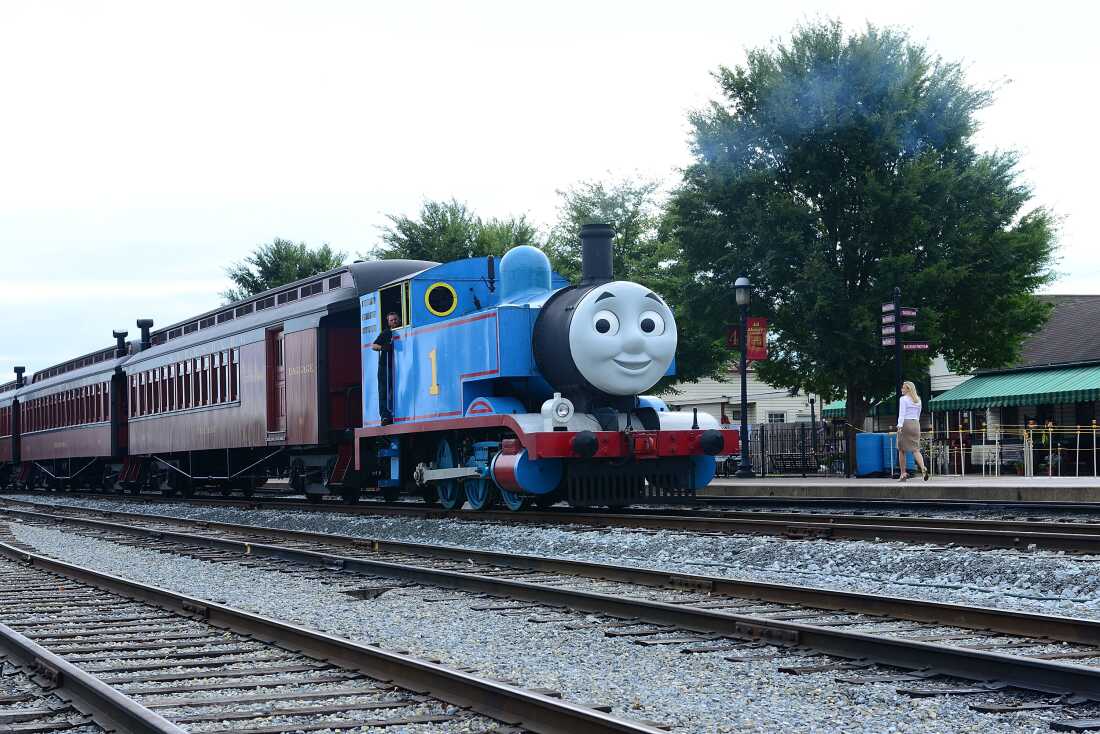
Thomas the Tank Engine arrives for Thomas & Friends: A Day Out with Thomas Tour at Strasburg Rail Road Museum in September 2014 in Lancaster County, Pa.
Lisa Lake/Getty Images for HIT Entertainment
hide caption
toggle caption
Lisa Lake/Getty Images for HIT Entertainment

-

 Health7 days ago
Health7 days agoNew Year life lessons from country star: 'Never forget where you came from'
-
/cdn.vox-cdn.com/uploads/chorus_asset/file/24982514/Quest_3_dock.jpg)
/cdn.vox-cdn.com/uploads/chorus_asset/file/24982514/Quest_3_dock.jpg) Technology7 days ago
Technology7 days agoMeta’s ‘software update issue’ has been breaking Quest headsets for weeks
-

 Business3 days ago
Business3 days agoThese are the top 7 issues facing the struggling restaurant industry in 2025
-

 Politics1 week ago
Politics1 week ago'Politics is bad for business.' Why Disney's Bob Iger is trying to avoid hot buttons
-

 Culture3 days ago
Culture3 days agoThe 25 worst losses in college football history, including Baylor’s 2024 entry at Colorado
-

 Sports3 days ago
Sports3 days agoThe top out-of-contract players available as free transfers: Kimmich, De Bruyne, Van Dijk…
-

 Politics2 days ago
Politics2 days agoNew Orleans attacker had 'remote detonator' for explosives in French Quarter, Biden says
-

 Politics1 day ago
Politics1 day agoCarter's judicial picks reshaped the federal bench across the country



